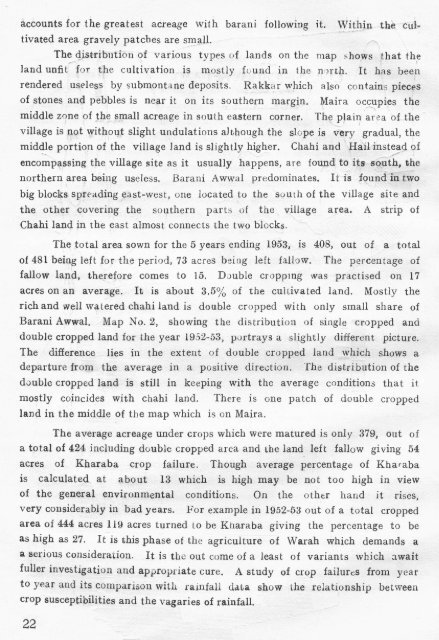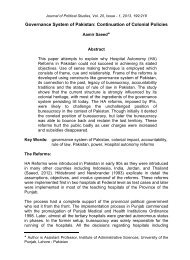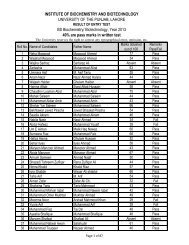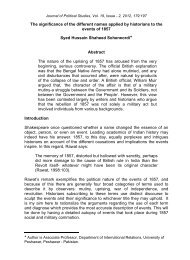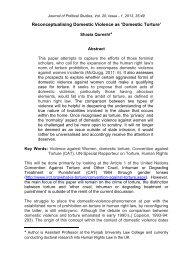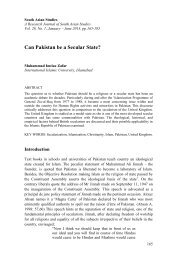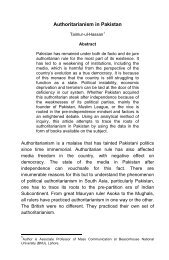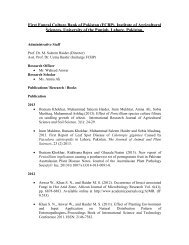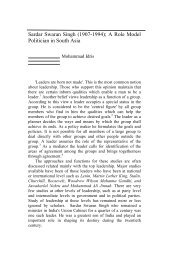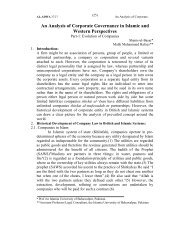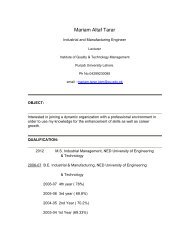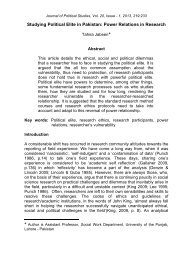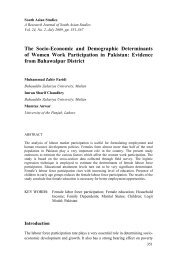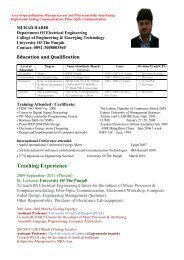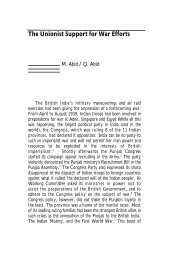pakistan geographical review 1954 - University of the Punjab
pakistan geographical review 1954 - University of the Punjab
pakistan geographical review 1954 - University of the Punjab
Create successful ePaper yourself
Turn your PDF publications into a flip-book with our unique Google optimized e-Paper software.
accounts for <strong>the</strong> greatest acreage with barani following it. Withjn <strong>the</strong> cultivated<br />
area gravely patches are small.<br />
Th~ distr ibntion <strong>of</strong> various types <strong>of</strong> lands on <strong>the</strong> map shows that <strong>the</strong><br />
land unfit for <strong>the</strong> cultivation is mostly found in <strong>the</strong> nor th. It has been<br />
rendered useless by submontane deposits. Rakkar which also contains pieces<br />
<strong>of</strong> stones and pebbles is near it on its sou<strong>the</strong>rn margin. Maira occupies <strong>the</strong><br />
middle zone <strong>of</strong> <strong>the</strong> small acreage in south eastern corner. The plain area <strong>of</strong> <strong>the</strong><br />
village is not without slight undulations although <strong>the</strong> slope is ;ery gradual, <strong>the</strong><br />
- /<br />
middle portion <strong>of</strong> <strong>the</strong> village land is slightly higher. Chahi and Hail instead <strong>of</strong><br />
encompassing <strong>the</strong> village site as it usually happens, are found to its south, <strong>the</strong><br />
nor<strong>the</strong>rn area being useless. Barani Awwal predominates. It is found in two<br />
big blocks spreading east-west, one located to <strong>the</strong> south <strong>of</strong> <strong>the</strong> village site and<br />
<strong>the</strong> o<strong>the</strong>r covering <strong>the</strong> sou<strong>the</strong>rn parts <strong>of</strong> <strong>the</strong> village area. A strip <strong>of</strong><br />
Chahi land in <strong>the</strong> east almost connects <strong>the</strong> two blocks.<br />
The total area sown for <strong>the</strong> 5 years ending 1953, is 408, out <strong>of</strong> a total<br />
<strong>of</strong> 48l being left for <strong>the</strong> period, 73 acres being left fallow. The percentage <strong>of</strong><br />
fallow land, <strong>the</strong>refore comes to 15. Double croppmg was practised on 17<br />
acres on an average. It is about 3.5% <strong>of</strong> <strong>the</strong> cultivated land. Mostly <strong>the</strong><br />
rich and well watered chahi land is double cropped with only small share <strong>of</strong><br />
Barani Awwal, Map No.2, showing t he distribution <strong>of</strong> single cropped and<br />
double cropped land for <strong>the</strong> year 1952-53, portrays a slightly different picture.<br />
The difference lies in <strong>the</strong> extent <strong>of</strong> double cropped land which shows a<br />
departure from <strong>the</strong> average in a positive direction. The distribution <strong>of</strong> <strong>the</strong><br />
double cropped land is still in keeping with <strong>the</strong> average conditions that it<br />
mostly coincides with chahi land. There is one patch <strong>of</strong> double cropped<br />
land in <strong>the</strong> middle <strong>of</strong> <strong>the</strong> map which is on Maira.<br />
The average acreage under crops which were matured is only 379, out <strong>of</strong><br />
a total <strong>of</strong> 424 including double cropped area and <strong>the</strong> land_ left fallow giving 54<br />
acres <strong>of</strong> Kharaba crop failure. Though average percentage <strong>of</strong> Khar aba<br />
is calculated at about 13 which is high may be not too high in view<br />
<strong>of</strong> <strong>the</strong> general environmental conditions. On <strong>the</strong> o<strong>the</strong>r hand it rises,<br />
very considerably in bad years. For example in 1952-53 out <strong>of</strong> a total cropped<br />
area <strong>of</strong> 444 acres 119 acres turned to be Kharaba giving <strong>the</strong> percentage to be<br />
as high as 27. It is this phase <strong>of</strong> <strong>the</strong> agriculture <strong>of</strong> Warah which demands a<br />
a serious consideration. It is <strong>the</strong> out come <strong>of</strong> a least <strong>of</strong> variants which await<br />
fuller investigation and appropriate cure. A study <strong>of</strong> crop failures from year<br />
to year and its comparison with rainfall data show <strong>the</strong> relationship between<br />
crop susceptibilities and <strong>the</strong> vagaries <strong>of</strong> rainfall.<br />
22


